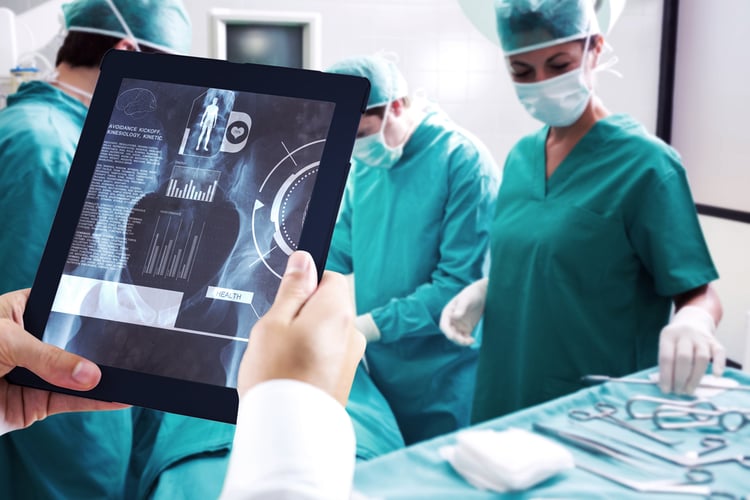If you have an iPhone, Apple Watch, Google Home, or a Ring Doorbell, then you own an IoT device. Simply put, an IoT device transmits data and is a global industry that is accelerating in growth.
According to IoT Analytics, 2023 is expected to see a growth of IoT devices by 18% to 14.4 billion, and this is projected to increase to 27 billion connected IoT devices, by 2025.
In this blog post, we will dive into the Internet of Things, IoT devices and examples, connectivity and networking, how IoT tech is enhancing efficiency, and how Datalink Networks can help with your IoT security.
Click here to learn about Microsoft Intune, a cloud-based mobile device management (MDM) service that helps you manage, and secure mobile devices used by your employees.
Internet of Things (IoT) Definition
The Internet of Things, or IoT, describes the network of physical objects that are embedded with software, sensors, and other technologies as a means to connect and exchange data with other systems and devices across the Internet. This collective network of devices facilitates communication between devices and the cloud, including between the devices themselves.
Thanks to the arrival of high bandwidth telecommunication and affordable computer chips, we now have a plethora of devices connected to the Internet, billions and counting. Because of this, everyday objects like vacuums, cars, and machines can utilize sensors for collection of data and respond sensibly to their users.
The Internet of Things assimilates everyday objects with the Internet. Computer engineers have been including sensors and processors to common use objects since the 90's. However, progress was slow at the start because the chips were bulky. Low power computer chips called RFID tags were originally used to track expensive equipment. As devices lowered in size, the chips also shrank and gained intelligence over time.
Why is IoT so important?
In the past few years, IoT has transformed into one of the most essential technologies of the 21st century. Now that we can connect everyday household objects to the Internet, like thermostats, kitchen appliances, and baby monitors, communication is achievable between people, processes, and things.
By method of low-cost computing, big data, the cloud, mobile technologies, and analytics, physical objects can exchange and collect data with minor human intervention. In this hyperconnected universe, digital systems can monitor, track, and adjust each interaction amongst connected things. There is cooperation and cohesiveness between the physical world and the digital world, paving the way for digital transformation.
How does IoT Work?
A general IoT system works through the real-time collection and sharing of data. An IoT system has three parts:
Smart Devices
This is a device, such as a television, security camera, or fitness equipment that has been granted with computing functionality. It gathers data from its environment, user inputs, or usage patterns and communicates this data across the Internet between IoT applications.
IoT Application
An IoT application is a collection of software and services that consolidates data received from numerous IoT devices. It applies machine learning, or AI technology, to scour this data and make mindful decisions. These decisions are communicated back to the IoT device and after, responds insightfully to inputs.
Graphical User Interface
The IoT device or fleet of devices can be operated through a graphical user interface. Examples of this include a website or mobile application that can be used to register and regulate smart devices.
What are IoT Devices?
IoT devices are the atypical computing devices that wirelessly connect to a network and are capable of transmitting data.
IoT consists of expanding internet connectivity beyond common devices, like laptops, desktops, smartphones, and tablets, to any range of non-internet enabled objects and physical devices. Also, they can be controlled and monitored from a remote location.
Read here for our comprehensive guide to build your own multi-layered security plan!
![]()
What are examples of an IoT device?
Connected devices are integral to an ecosystem where every device communicates with other related devices in an environment to automate home and industry activities. They can communicate usable sensor data with businesses, users, and any other intended groups. The device types can be separated into three main categories:
- Consumer
- Enterprise
- Industrial
Consumer connected devices comprise of smart speakers, smart TVs, toys, wearables, and smart appliances. In a smart home, for example, devices are built to sense and respond to an individual's presence. When someone drives home and would like to park, their vehicle communicates with the garage to open the door.
Once indoors, the thermostat is already set to their desired temperature, and the lighting is adjusted to a lower color and intensity, as their smart watch data signifies that this person is under distress. Other types of smart home devices include robotic vacuum cleaners, such as the Roomba, that understand what areas in a home need to be cleaned the most.
The following are further examples of IoT devices:
Connected Cars
There are many methods in which vehicles, like cars, can be connected to the Internet. This can be done through infotainment systems, smart dashcams, or even the connected gateway. Data is collected from the accelerator, speedometer, brakes, wheels, and fuel tanks to track vehicle health as well as performance.
Connected cars have a wide range of features, including:
- Allowing parents to track their children's driving patterns
- Surveilling rental car fleets to improve fuel efficiency and lower costs
- Alerting friends and family immediately in case of a car accident
- Anticipating and preventing vehicle maintenance needs
Connected Homes
Smart home devices prioritize the safety and efficiency of the house. Devices like smart outlets track electricity usage and smart thermostats provide better temperature control. Hydroponic systems can use IoT sensors to monitor the garden while IoT smoke detectors are capable of sensing tobacco smoke. Home security systems such as security cameras and door locks, can detect and prevent threats, alerting homeowners in real time.
Connected home devices can be used for the purpose of:
- Turning off any devices that are not in use
- Rental property maintenance and management
- Recovering lost items like keys or wallets
- Automating everyday tasks like brewing your morning cup of coffee
Smart Buildings
Buildings, including commercial buildings and college campuses, use IoT applications to achieve greater operational efficiencies.
IoT devices located in smart buildings are used for:
- Cutting down energy consumption
- Minimizing maintenance costs
- Making more efficient use of workspaces
Smart Cities
IoT applications have helped make urban planning and infrastructure maintenance more efficient. Governments, especially, utilize IoT applications to overcome problems in health, infrastructure, and the environment.
IoT applications may be used for:
- Measuring radiation levels and air quality
- Lowering energy bills with smart lighting systems
- Detecting maintenance needs for critical infrastructures like bridges, streets, and pipelines
- Maximizing profits through efficient parking management
IoT Device Connectivity and Networking
The networking, communication, and connectivity protocols paired with internet accessible devices widely depend on the specific IoT application deployed. Just as there are several different IoT applications, there are also different communication and connectivity options.
Communication protocols can include CoAP, DTLS, DDS and AMQP. Wireless protocols include IPv6, LPWAN, Bluetooth Low Energy, RFID, and Z-Wave. Satellite, cellular, Wi-Fi and Ethernet are also available for use.
Each option has its tradeoffs in terms of power consumption, bandwidth, and range, all of which must be considered when selecting connected devices and protocols for a specific IoT application.
Most of the time, IoT devices connect to an IoT gateway or another edge device, where data can either be dissected locally or passed off to the cloud for further analysis. Some devices have consolidated data processing capabilities to reduce the amount of data sent to the cloud or data center. This kind of processing often exercises machine learning capabilities that are merged into the device.
How IoT Tech is Enhancing Efficiency
The Internet of Things is transforming industries across all divisions, ranging from retail to healthcare. Due to the ability of IoT technologies to reduce costs and increase efficiencies, more and more industries are seeing the value in embracing them. The IoT landscape shows no signs of slowing down moving forward. Rather, a report by Business Insider claims that the, "IoT industry is going to be a transformative force across all organizations, projecting that there will be more than 41 billion IoT devices by 2027" (EP&T).
Verticals with the most IoT projects, according to IoT analytics, consist of transportation and mobility, retail, buildings, and healthcare. We will be focusing mainly on the healthcare industry and how they are using IoT technology to drive efficiency, reduce downtime, and cut costs.
Healthcare Industry
IoT in healthcare is being utilized for the remote monitoring of patients, measuring data such as blood pressure, glucose level, cardiac status, and more. Hospitals are using smart beds equipped with IoT sensors that sense a patient's presence. This way, they can provide adequate support by automatically adjusting the bed to the right angle and pressure without hospital staff needing to intervene.
In the current COVID-19 world, IoT is also being utilized to remotely monitor seniors who either live alone or inside a care facility. IoT connected heart-rate monitors, thermometers, and ventilators allow for patients who require more rigorous care to be remotely monitored, which lowers the risk of infection getting spread further.
Overall, IoT is transforming the healthcare industry for patients, ensuring higher quality care, improved treatment outcomes, and reduced costs. For healthcare providers, IoT is responsible for better processes and workflows, improved performance, and enhancing the patient experience.
With that said, Healthcare IoT and IoT for any industry still faces its fair share of challenges. IoT-enabled devices capture large amounts of data, including sensitive information, which leads to data security concerns. It is vital to implement sufficient security measures into your organization.
How Datalink Can Help with Your IoT Security
Vulnerabilities are a severe and recurring issue in the IT field. This is because vulnerabilities appear from multiple layers of IoT devices.
Datalink Networks can help remediate vulnerabilities within your web applications and associated software to prevent systems from being compromised.
Our highly trained, Level 2 and above engineering team can ensure your business IOT device security, from any location.
Talk to our team about personalizing an IT solution that is guaranteed to help your business run more efficiently.





